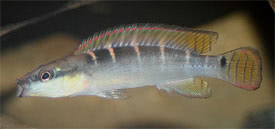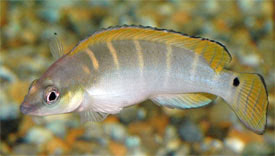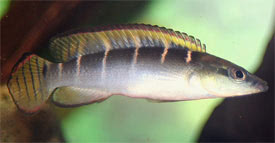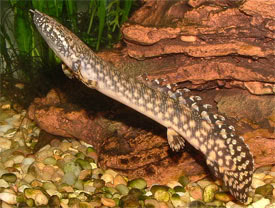
 Magyarul / Hungarian
Magyarul / Hungarian



- Scientific name: Crenicichla compressiceps
- Common name: Compressiceps Dwarf Pike Cichlid, Green Dwarf Pike
- Group: Cichlids
- Habitat: South America; Brazil,
- Size: 8 cm.
- Biotope: Endemic to the Rio Tocantis Basin and Araguaia
- Social behavior: It is occasionally belligerent towards conspecifics. Even much larger fishes are not exempt from being attacked by brooding parents.
- Diet: Carnivorous; It is a specialized carnivore which feeds on small invertebrates in nature. All small frozen foods (Artemia, mosquito larvae, and Mysis) as well as pond plankton, worms and even flake foods are accepted in captivity.
- Breeding: Hard
- Tank: Minimum 130 litres
- Population: 1 males and 2-3 females for 200 litres
- Decoration: The aquarium needs to be planted densely, with dimmed lights or floating plants. Use stones, roots, and plants to create a multitude of niches and secluded areas. Small caves with narrow, restrictive entrances are desired.
- Temperature: 24-27 °C
- pH: 5.5-7.5
- Hardness: 8-20 NK°
- Lifespan: 5-8 years
Description: In some populations, the males have red-fringed fins (Araguaia). Its coloration and compressed head clearly distinguishes it from other small pike cichlids. The body is silver-blue in colour with vertical white bands from the dorsal to the mid second of the body, with a darker mark on the top section of the body at the beginning of the dorsal fin. Viewed from above, the snout is rounded, but it is pointed in profile. Males are slightly larger, and their yellow dorsal, anal and caudal fins have prominent vertical striations. Females have pale orange fins without a design. They have good vision in the night and will often feed in the dark.
Before breeding condition a pair of Compressiceps by feeding high quality live or frozen foods. Courtship is initiated by the colorful male. Despite the extremely soft water of its natural habitat, it will breed in water that has a hardness of approximately 15 °dGH. The eggs are laid in a cave. The 25 to 50 eggs are typically hung by an adhesive filament from the top of the spawning cave. Fry will hatch in 2-3 days, and may become free swimming within another 4 days. Fry will grow quickly and parents will look after them very carefully.


























